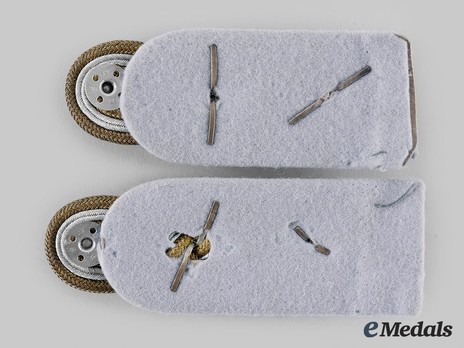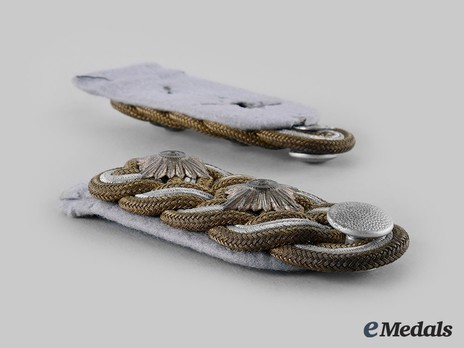Waffen-SS Obergruppenführer Shoulder Boards
CATEGORY: Version
SKU: 50.GOR.01.03.02.01.01.02.001.000
Estimated market value:



Estimated market value:
A pair of shoulder boards, constructed of a mouse grey wool base, the obverse bears interwoven Russian braid in gilt and silver-aluminum wire thread, with two rank pips per board and topped with a pebbled silver magnetic metal button, the reverse is plain and presents the attachment prongs of the obverse rank pips, the reverse of the button is marked “D R G M” measuring 106.97 mm (l) x 40.88 mm (w), very fine.
Waffen-SS shoulder boards were introduced in 1935 for NCO/EMs and in 1938 for Officers. They indicated the rank and service branch of the wearer. They closely follow the design of Wehrmacht shoulder boards, but with slight differences.
The shoulder boards of all Officer grades, excluding General Officers, started with a black base upon which a secondary layer in the appropriate service branch colour (Waffenfarbe) was attached. A bullion braid or cord was then fastened to the top. General Officer ranks had no Waffenfarbe piping, and the underlay of their shoulder boards was either light or mouse grey.
NCO/EM’s (Non-Commissioned Officers/Enlisted Men) shoulder boards were made with a wool base, which always had a black upper side. Some shoulder boards have a grey wool underside, while others have a black underside. The outer piping of the shoulder boards denoted service branch, while tresses and metal pips denoted rank.
In the pre-war period, NCO tresses were manufactured out of silver coloured thread. Later shoulder boards were produced using white cotton thread, and the final design was manufactured using grey thread. Tress on Tropical style shoulder boards was in copper or brown colour.
Enlisted Men that were deemed NCO candidates wore a single stripe of tress at the bottom of their shoulder straps if they had committed to 12 years of service, while those that hadn’t wore a single strand of twist cord, either silver-coloured or in the wearer’s Waffenfarbe.
Similarly, NCOs who were Officer candidates wore two stripes of tress at the bottom of their shoulder straps.
Rank pips for General ranks were silver-coloured. Officers were supposed to wear bronze pips, but this was mostly ignored. Instead, gilt pips like the ones on Army shoulder boards were used. NCOs wore white metal pips.
A variety of unit numbers and other cyphers could be added to shoulder boards to indicate membership in an elite formation or specialist unit. They could also indicate the assignment or training school of the wearer.
Officer grades received metal cyphers in gilt, while NCOs received silvered metal cyphers. EMs wore removable cloth loops with an embroidered cypher or had the cyphers directly embroidered onto their shoulder straps.
Pre-1940 cyphers featured Gothic script, while starting in 1940 this was changed to Latin script.
Career insignia includes, but are not limited to:
Medical: Rod of Asclepius
Veterinary: Snake
Technical Services: Wheel Cog
Flak: Fl
Panzerjäger: P
Training/School insignia include, but are not limited to:
Music School: Lyre
Unterführerschule Radolfzell: US R
Unterführerschule Lauenburg: US L
Junkerschule Tölz: JS T
Junkerschule Braunschweig: JS B
Haupt Reiter-Schule: R SH
Regiment/Division insignia include, but are not limited to:
SS Leibstandarte Adolf Hitler: LAH
SS-Standarte “Deutschland”: D
SS-Standarte “Germania”: G
SS-Standarte “Der Führer”: DF
Panzer-Lehr-Division: L
A simplified approximation of branch colours follows:
Silver or grey: Generals
White: Infantry
Red: Artillery
Black: Engineers (“Pioniere”)
Lemon yellow: Signals
Pink: Armoured/Anti-Tank
Copper brown: Reconnaissance (1940-1942)
Golden yellow: Cavalry/Reconnaissance (1942-1945)
Dark blue: Medical
Grass green: Mountain Troops
Light blue: Supply Troops
Orange: Field Police/Special & Technical Services
Dark Green: Reserve & Special Services Officers (1940-1942)
Red & Grey: Special Services Officers (1942-1945)
Carmine: Veterinary
Wine red: Judicial
Light brown: Concentration Camp Personnel
Light pink: Transport Troops
Light salmon pink: Military Geologists
Sky blue: Administration
Only the more common branches among the above mentioned ones were included in certain MedalBook chapters. The rarer items of uncommon branches may be added in the future if images become available.
The rank of SS-Obergruppenführer was first adopted by the SS in 1933 and was the highest rank in the Waffen-SS until 1944 when the rank of Oberstgruppenführer was added. The rank was first added to the Allgemeine SS rank system in 1942.
The equivalent rank in the Wehrmacht was General.
SS-Obergruppenführer shoulder boards feature interwoven gold bullion and aluminium cords. Two pips are used to denote the rank.

Comments
Sign in to comment and reply.


Scroll Top